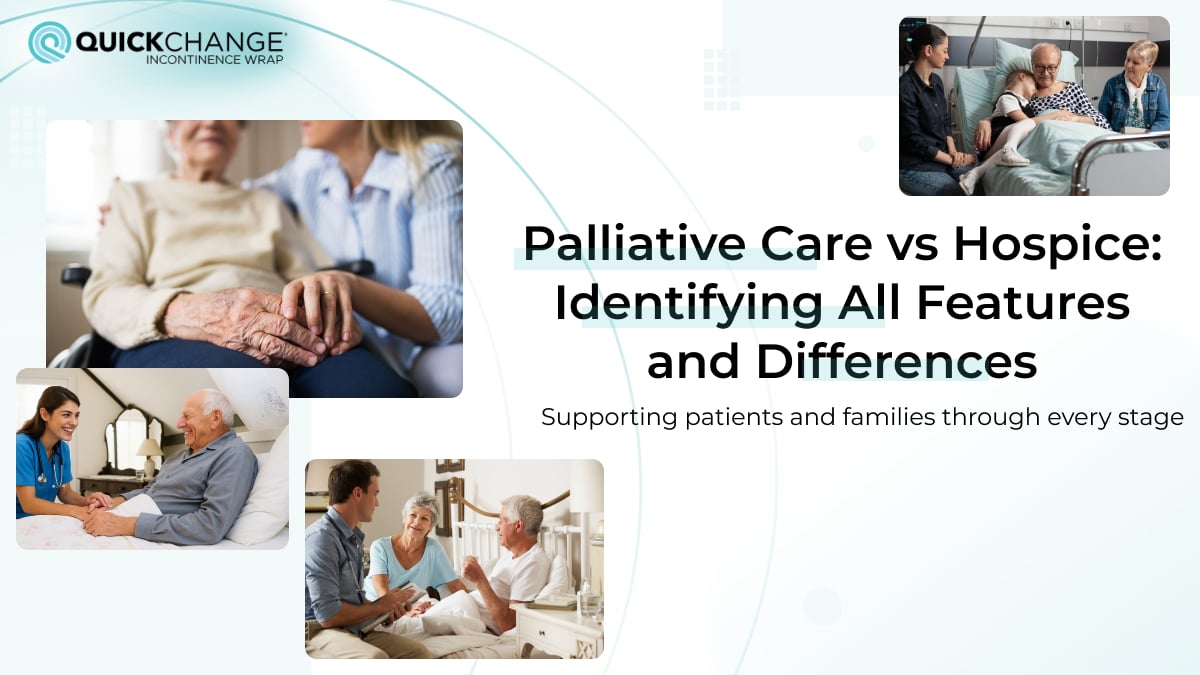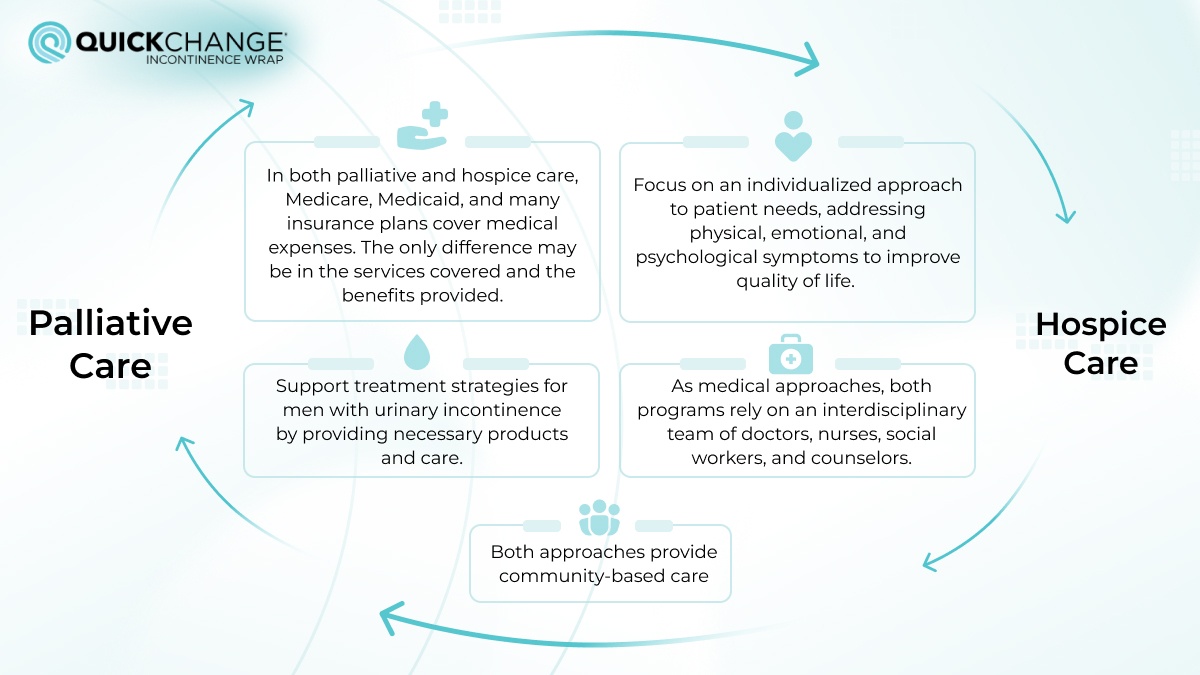Palliative Care vs Hospice: Identifying All Features and Differences

Despite the fact that men often do not admit to having urinary incontinence and underestimate the loss of bladder control, new solutions are emerging to address and manage this problem. In addition to the burden of urinary incontinence itself, it also leads to feelings of embarrassment and loss of confidence in daily life. Underestimating treatment can also cause skin irritation and even infections.
To address these issues, palliative and hospice care have been developed as forms of support for patients and their families. Recognized by the World Health Organization as a medical specialty, palliative and hospice care are extremely important today. So which one is right for you or your relative? Understanding what's the difference between palliative care and hospice will help you make well-rounded decisions about treatment. Read the article to learn all the details and find the best way to manage urinary incontinence with QuickChange.
What is Palliative Care?
The main focus of palliative care is on patients with serious illnesses. The official palliative care meaning is as follows:
“Palliative care is a specialized form of medical care aimed at improving the quality of life and health of patients by preventing and alleviating suffering through early detection, assessment, and treatment of diseases and other physical, emotional, and social problems. This care is directed not only at patients but also at their family members in order to support their mental well-being.”
The National Institute of Health emphasizes that thanks to palliative care, patients with serious illnesses such as cancer, heart failure, neurological diseases, or severe diabetes receive significant health benefits and feel much better. Palliative care focuses on treating symptoms, not just prolonging life. Treatment of such symptoms includes:
-
Pain monitoring and relief
-
Fatigue prevention
-
Breathing difficulties monitoring
-
Emotional stress management and much more
Key difference: Unlike some types of care, as for instance in hospice, palliative care can be provided early in the course of an illness instead of only at the end of life.
Managing Urinary Incontinence with Palliative Care
When describing palliative care in detail, we should pay attention to managing urinary incontinence in this setting. In addition to serious illnesses that fall under palliative care, patients may also experience urinary incontinence, which is a very important issue that caregivers must take into account. This problem is one of the most unpleasant symptoms for men, negatively affecting their entire well-being.
However, caring for patients with this problem is not a challenge for palliative care professionals. As part of their care, doctors, nurses, and caregivers work together to treat patients with urinary incontinence. Thus, they are required to:
-
Conduct regular examinations of the patient's condition.
-
Provide absorbent or other means for urine drainage or absorption.
-
Prevent infections.
-
Provide emotional support.
In other words, they must provide all the necessary services to keep the patient healthy and satisfied, ensuring comfort during treatment and in everyday life. Thanks to active monitoring of urinary incontinence and other symptoms during palliative care, men and their families often experience less distress, improved daily functioning, and better quality time together.
To achieve satisfaction among patients with urinary incontinence, palliative care workers must not only provide patients with incontinence management products, but also select and provide the best of them. There are many types of such products to choose from, differing not only in brand but also in function and purpose. The best incontinence management product for patients with limited mobility is QuickChange wraps. 
Unlike other products, the only drawback of these wraps is that they are designed for use in a sitting or lying position and are not suitable for an active lifestyle.
However, in their intended use, these wraps are unmatched, offering the following advantages for the complete comfort of both the patient and the caregiver:
-
One size fits all.
-
Unique shape, no need to undress or roll over.
-
Change in 60 seconds.
-
Provides maximum absorbency.
-
Holds 17 ounces.
-
Promotes skin health.
The listed useful features have been specially developed and tested. The effectiveness of the wraps and their convenience have been proven by the reviews of our customers, which you can see on our product page. Order a trial pack now!
What is Hospice Care?
Hospice and palliative care are often confused, and the distinctions between them are frequently misunderstood. Our article is dedicated to this topic so that you can learn the specific difference, which is quite simple and becomes clear from the hospice care meaning, which states:
“Hospice care is a specialized system of care for people who are nearing the end of their lives. Hospice care is provided when treatment of the disease is not effective and will not lead to recovery, or is undesirable on the part of doctors or patients, as noted by the American Cancer Society. Such patients are provided with care aimed at alleviating suffering and ensuring comfort. According to the law under the Medicare program, only patients with a life expectancy of six months or less are eligible for hospice care in the United States. For such patients, hospice care is covered by Medicare, Medicaid, and most private insurance plans.”
One of the features of hospice care is the option for teams to provide it in different settings, whether at home, assisted living facilities, or inpatient units, anywhere according to the patient's needs. Hospice teams include multidisciplinary professionals, including doctors, nurses, social workers, and counselors.
Key difference: Hospice care is considered a form of palliative care rather than a separate medical specialty, with a specific purpose for the terminal stages of diseases.
Managing Urinary Incontinence with Hospice Care
The hospice care program monitors all patient needs, as this is its goal. The same applies to the care of patients with urinary incontinence. This problem can be quite common in patients at the end of their lives, especially if they suffer from serious illnesses such as amyotrophic lateral sclerosis.
As with palliative nursing, hospice program caregivers are required to provide comprehensive care for patients with urinary incontinence. This includes educating caregivers, providing patients with absorbent products, monitoring skin condition and ensuring its protection and health, as well as preventing infections. Such services are part of the hospice care mission, which is to reduce discomfort and allow patients to spend their remaining time in peace and close to their families.
Key Differences in Palliative Care vs Hospice Care
Having examined hospice vs palliative care separately and in detail, we will now draw conclusions by highlighting the main difference between hospice and palliative care. Although they are often confused, they actually have clear differences.
Features of palliative care:
-
Palliative care can be appointed as soon as a patient is diagnosed with a serious illness such as heart failure, cancer, dementia, severe diabetes, etc.
-
Assistance is not limited to the end of life.
-
Palliative care focuses on alleviating symptoms, improving quality of life, and supporting both the patient and their family.
-
Care is provided in a parallel course with disease slowing or treatment.
-
Veterans may be eligible for palliative care through the VA.
Features of hospice care:
-
A subtype of palliative care that focuses on patients in terminal conditions.
-
Patients can only become part of hospice care when their life expectancy is limited to approximately six months or less.
-
Medical procedures are completely discontinued, with the focus remaining solely on medications and products that provide comfort and peace.
-
Hospice care provides comprehensive support to both patients and their caregivers.
-
Hospice care can be received at home, in assisted living facilities, or in inpatient units.
-
Hospice services are covered by Medicare, Medicaid, or other private insurance programs.
-
The program includes bereavement services for family and caregivers.
|
Care approach |
Appointment |
Period of assistance |
Focus of care |
Treatment |
Location |
|
Palliative |
As soon as a patient is diagnosed with a serious illness |
Depends on individual needs |
Alleviating symptoms, improving quality of life |
Care in parallel to medical treatment |
Home, a hospital, nursing homes, and outpatient clinics. |
|
Hospice |
Only when life expectancy is limited to six months or less |
Till the end of life |
Provision of comfort and relief |
Medical procedures are completely discontinued |
Wherever the patient lives. Nursing and long-term care facilities. |
Similarities in Palliative vs Hospice Care
Now, after a detailed analysis and highlighting of the differences between these types of care, we can see how palliative vs hospice care differ in terms of treatment and goals. However, they are related by the fact that hospice care is a subtype of palliative, which means that they have similarities. Let us examine how these approaches are similar:
-
Focus on an individualized approach to patient needs, addressing physical, emotional, and psychological symptoms to improve quality of life.
-
Support treatment strategies for men with urinary incontinence by providing necessary products and care.
-
As medical approaches, both programs rely on an interdisciplinary team of doctors, nurses, social workers, and counselors.
-
In both palliative and hospice care, Medicare, Medicaid, and many insurance plans cover medical expenses. The only difference may be in the services covered and the benefits provided.
-
Both approaches provide community-based care.

Consultations and open communication between healthcare professionals and patients or their families help to choose the most suitable approach. Based on these consultations, patients can make informed decisions and choose the most appropriate course of care. Read more about how to choose the right type of care further in the article.
How to Choose Palliative vs Hospice Care?
These two types of care actually have specific differences in their purpose, which determines which of them is more appropriate to apply. Let's take a look at the conditions under which you should choose one type or the other.
Palliative care
This type of care is appropriate for patients with serious or chronic illnesses who suffer from persistent symptoms, functional decline, or urinary incontinence. Patients should consider palliative care under the following conditions:
-
progressive fatigue
-
difficulty with daily activities
-
increased pain
-
mobility problems
-
increased dependence on caregivers
Hospice care
This type of care has one specific purpose, and you can only get it under certain strict conditions. The purpose is to care for patients who are in a terminal state. The conditions under which this care can be obtained are regulated by law for insurance coverage purposes. The main condition for joining is that the patient's life expectancy is six months or less. Of course, there are health conditions under which you may be eligible for this program, but it is first assessed by medical professionals using the Palliative Performance Score (PPS). The conditions under which you can become a patient receiving assistance include:
-
rapid deterioration of health
-
inability to control the disease with medical methods
-
significant loss of functional abilities
-
improper nutrition
Regardless of the patient's condition, it is important to first discuss care options with your doctor. Consultations and discussions will not only enable you to choose the right type of care, but will also inform medical staff about the specific conditions required by the patient and the necessary treatment and care needs.
Reasons for Discontinuation of Palliative and Hospice Care
There are several reasons specified in the legislation for which a patient may lose the right to receive palliative or hospice care, including:
Patient refusal. The patient decides to discontinue care due to improvement in symptoms, condition, or at their own request.
Exceeding the hospice term. As we have already mentioned, a patient can only be admitted to a hospice if their life expectancy does not exceed 6 months. If the patient has been in the care program for longer than this, they are sent for reassessment.
Transfer. The patient is transferred to another facility or to another care program.
Resumption of medical treatment. If the patient or their family decides to continue treatment and fight for a life, the patient can leave hospice care.
Expulsion from the facility. The patient may be expelled from the facility in cases of destructive behavior.
Family issues. Care may be discontinued in cases of non-cooperation and abuse by family members.
Death of the patient. Care is legally discontinued.
FAQs
Who can benefit from palliative care?
For patients with serious illnesses, palliative care will bring significant relief and improvement. These serious illnesses include heart failure, chronic obstructive pulmonary disease, cancer, dementia, Parkinson's disease, and many others. In addition, organized palliative care services will provide relief for elderly people with symptomatic discomfort and mobility issues.
Will my symptoms be relieved?
Yes, regardless of the care program you choose, each of them will aim to provide you with comfort and relieve any symptoms through medication or care.
Will Medicare pay for palliative care?
Yes, however, many organizational details and services will depend on your benefits, perks, and treatment plan.
Does palliative care mean death rather than treatment?
No, end-of-life care is hospice care, not palliative care. Palliative care does not replace medical treatment. It can be provided alongside such therapies as chemotherapy, dialysis, or surgery to make the treatment process easier.
When should someone be offered palliative care?
Palliative care can be provided at any stage of a severe illness. It is recommended when symptoms such as pain, fatigue, or emotional distress cause significant discomfort.
Is palliative care the same as hospice?
Actually, no. On the contrary, hospice care is a subtype of palliative care but has a clear purpose. Palliative care can be received at any stage of the disease and supports treatment, while hospice care is specifically designed for people who are nearing the end of their lives.
What is hospice care at home?
Hospice care is universal in that it can be provided anywhere, including the patient's home. The convenience of home hospice care ensures that patients in the terminal stage are provided with comfort while remaining in their home environment with family and friends.
Conclusion
By specifically identifying the definitions, similarities, and differences, we can draw conclusions. Both types of care are extremely important for American citizens. Although these types of care are often mistaken for each other, it is actually difficult to confuse them because they have significant differences in their goals and purposes.
Palliative care is provided to patients with serious illnesses that significantly complicate their daily lives, and it can be provided simultaneously with the treatment of the disease. Meanwhile, hospice care is a subtype of palliative care. It is also designed to help patients in their daily lives by improving their well-being, but it is intended only for patients who are near death. This purpose is clearly defined by law, which makes hospice care difficult to confuse with other types of care. Based on these purposes, patients can understand which type of care is right for them.
Finally, both types of care provide the best possible care for patients with urinary incontinence. This care includes everything necessary, such as providing products, monitoring skin condition, and preventing infections. The best product for incontinence control includes QuickChange wraps, which ensure the best possible experience for palliative and hospice care patients.
This content is for informational purposes only and is not intended as a substitute for professional medical advice, diagnosis, or treatment. Always seek the advice of your physician or other qualified health provider with any questions you may have regarding a medical condition. Never disregard professional medical advice or delay seeking it because of something you have read or seen here.

